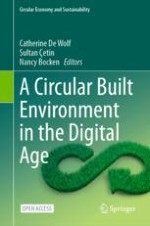5.1 Data Templates, Material Passports, and Digital Product Passports
5.1.1 Differences Between MPs and DPPs
5.1.2 Data Templates for MPs and DPPs
5.1.3 The Development of Passport Instruments
5.2 Passport Instruments in the Built Environment
5.2.1 MPs and Life Cycles
5.2.2 MPs and Digital Platforms
5.3 Passport Instruments for a Circular Economy
5.3.1 MP-Related Concepts
5.3.2 MPs for New and Existing Buildings
5.4 Examples from Research and Practice
5.4.1 Examples from Research
5.4.2 Examples from Practice
5.5 Business Models for Passport Instruments in a Circular Built Environment
-
Initiation and market rollout: The Madaster platform development is funded by private investors (50%), grants and subsidies (25%), and early adopters (25%).
-
Service provision and functional development: Usage of the Madaster platform requires a yearly subscription, where pricing depends on the country and type of client. The subscription includes MPs, embodied carbon calculations, environmental and circularity assessments, and residual value reporting.
-
Supervision and R&D: Madaster is supervised by the independent, not-for-profit Madaster Foundation. This foundation owns the brand IP and assures the availability of the (meta) data for public usage. A partnership agreement between Madaster Foundation and the service company describes the supervisory activities, including the possibility to select an alternative service company in case of noncompliance with the supervision criteria.
5.6 Discussion
5.7 Key Takeaways
-
Material passports (MPs) are a main enabler of a circular economy in the built environment, because they consist of relevant information that facilitates maintenance, repair, reuse, etc.
-
MPs give building materials and elements value for present use, recovery, and reuse.
-
Several passport instruments exist in academia and practice.
-
Format, structure, and terminology for MPs are not standardised.
-
Several digital technologies can support the gathering, storing, and maintaining information of new and existing buildings.
